#ecological perspective
Explore tagged Tumblr posts
Text
Understanding the Circle of Life: Exploring its Biological, Ecological, Cultural, and Philosophical Aspects
The “circle of life” is a metaphorical concept that describes the interconnectedness and cyclical nature of all living things. It is a fundamental idea in many cultures and religions, representing the continuous cycle of birth, growth, death, and rebirth. The concept is often depicted as a circle or wheel, with each point representing a different stage in the cycle. The circle of life can be…

View On WordPress
#Biological Perspective#Biomimicry#Circle of Life#Cultural Perspective#Ecological Perspective#Philosophical Perspective#Sustainability#Traditional Ecological Knowledge
1 note
·
View note
Text
About the entanglement of "science" and Empire. About geographic imaginaries. About how Empire appeals to and encourages children to participate in these scripts.
Was checking out this recent thing, from scavengedluxury's beloved series of posts looking at the archive of the Budapest Municipal Photography Company.

The caption reads: "Toys and board games, 1940."
And I think the text on the game-box in the back says something like "the whole world is yours", maybe?
(The use of appeals to science/progress in imperial narratives probably already well-known to many, especially for those familiar with Victorian era, Edwardian era, Gilded Age, early twentieth century, etc., in US and Europe.)
And was struck, because I had also recently gone looking through nemfrog's posts about the often-strange imagery of children's material in late nineteenth- and early twentieth-century US/Europe. And was disturbed/intrigued by this thing:
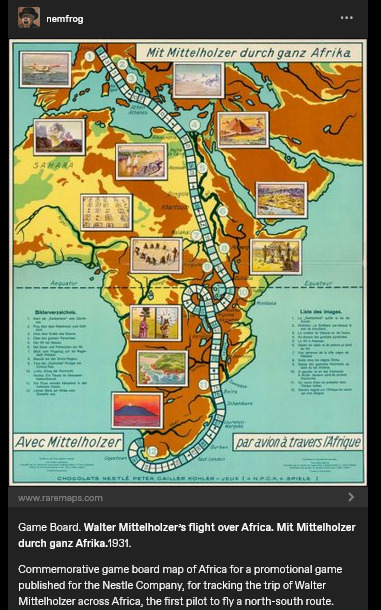
Caption here reads: "Game Board. Walter Mittelholzer's flight over Africa. [...] 1931. Commemorative game board map of Africa for a promotional game published for the N*stle Company, for tracking the trip of Walter Mittelholzer across Africa, the first pilot to fly a north-south route."
Hmm.
"Africa is for your consumption and pleasure! A special game celebrating German achievement, brought to you by the N*stle Company!"
1930s-era German national aspirations in Africa. A company which, in the preceding decade, had shifted focus to expand its cacao production (which would be dependent on tropical plantations). Adventure, excitement, knowledge, science, engineering prowess, etc. For kids!
Another, from a couple decades earlier, this time British.
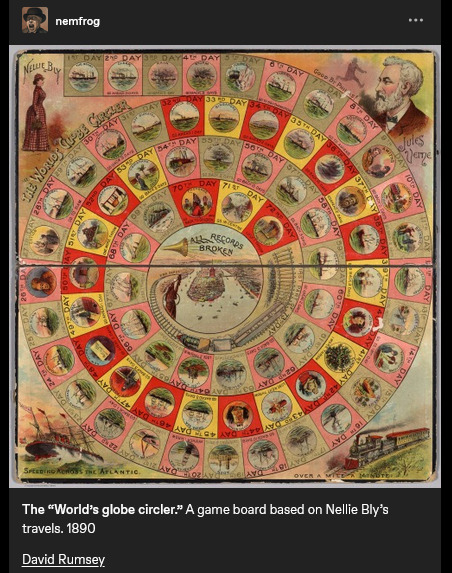
Caption reads: "The "World's globe circler." A game board based on Nellie Bly's travels. 1890." At center, a trumpet, and a proclamation: "ALL RECORDS BROKEN".
Same year that the United States "closed the frontier" and conquered "the Wild West" (the massacre at Wounded Knee happened in December 1890). A couple years later, the US annexed Hawai'i; by decade's end, the US military was in both Cuba and the Philippines. The Scramble for Africa was taking place. At the time, Britain especially already had a culture of "travel writing" or "travel fiction" or whatever we want to call it, wherein domestic residents of the metropole back home could read about travel, tourism, expeditions, adventures, etc. on the peripheries of the Empire. Concurrent with the advent of popular novels, magazines, mass-market print media, etc. Intrepid explorers rescuing Indigenous peoples from their own backwardness. Many tales of exotic allure set in South Asia. Heroic white hunters taking down scary tigers. Elegant Englishwomen sipping tea in the shade of an umbrella, giggling at the elephants, the local customs, the strange sights. Orientalism, tropicality, othering.
I'd lately been looking at a lot of work on race/racism and imperative-of-empire in British scientific and pop-sci literature, especially involving South and Southeast Asia. (From scholars like Varun Sharma, Rohan Deb Roy, Ezra Rashkow, Jonathan Saha, Pratik Chakrabarti.) But I'd also lately been looking at Mashid Mayar's work, which I think closely suits this kinda thing with the board games. Some of her publications:
"From Tools to Toys: American Dissected Maps and Geographic Knowledge at the Turn of the Twentieth Century". In: Knowledge Landscapes North America, edited by Kloeckner et al., 2016.
"What on Earth! Slated Globes, School Geography and Imperial Pedagogy". European Journal of American Studies 16, number 3, Summer 2020.
Citizens and Rulers of the World: The American Child and the Cartographic Pedagogies of Empire, 2022.
Discussing her book, Mayar was interviewed by LA Review of Books in 2022. She says:
[Quote.] Growing up at the turn of the 20th century, for many American children, also meant learning to view the world through the lens of "home geography." [...] [T]hey inevitably responded to the transnational whims of an empire that had stretched its dominion across the globe [recent forays into Panama, Cuba, Hawai'i, the Philippines] [...]. [W]hite, well-to-do, literate American children [...] learned how to identify and imagine “homes” on the map of the world. [...] [T]he cognitive maps children developed, to which we have access through the scant archival records they left behind (i.e., geographical puzzles they designed and printed in juvenile periodicals) [...] mixed nativism and the logic of colonization with playful, appropriative scalar confusion, and an intimate, often unquestioned sense of belonging to the global expanse of an empire [...]. Dissected maps - that is, maps mounted on cardboard or wood and then cut into smaller pieces that children were to put back together - are a generative example of the ways imperial pedagogy [...] found its place outside formal education, in children's lives outside the classroom. [...] [W]ell before having been adopted as playthings in the United States, dissected maps had been designed to entertain and teach the children of King George III about the global spatial affairs of the British Empire. […] [J]uvenile periodicals of the time printed child-made geographical puzzles [...]. [I]t was their assumption that "(un)charted," non-American spaces (both inside and outside the national borders) sought legibility as potential homes, [...] and that, if they did not do so, they were bound to recede into ruin/"savagery," meaning that it would become the colonizers' responsibility/burden to "restore" them [...]. [E]mpires learn from and owe to childhood in their attempts at survival and growth over generations [...]. [These] "multigenerational power constellations" [...] survived, by making accessible pedagogical scripts that children of the white and wealthy could learn from and appropriate as times changed [...]. [End quote.] Source: Words of Mashid Mayar, as transcribed in an interviewed conducted and published by M. Buna. "Children's Maps of the American Empire: A Conversation with Mashid Mayar". LA Review of Books. 11 July 2022.
Some other stuff I was recently looking at, specifically about European (especially German) geographic imaginaries of globe-as-playground:
The Play World: Toys, Texts, and the Transatlantic German Childhood (Patricia Anne Simpson, 2020) /// "19th-Century Board Game Offers a Tour of the German Colonies" (Sarah Zabrodski, 2016) /// Advertising Empire: Race and Visual Culture in Imperial Germany (David Ciarlo, 2011) /// Learning Empire: Globalization and the German Quest for World Status, 1875-1919 (Erik Grimmer-Solem, 2019) /// “Ruling Africa: Science as Sovereignty in the German Colonial Empire and Its Aftermath” (Andrew Zimmerman. In: German Colonialism in a Global Age, 2014) /// "Exotic Education: Writing Empire for German Boys and Girls, 1884-1914". (Jeffrey Bowersox. In: German Colonialism and National Identity, 2017) /// Raising Germans in the Age of Empire: Youth and Colonial Culture, 1871-1914 (Jeff Bowersox, 2013) /// "[Translation:] (Educating Modernism: A Trade-Specific Portrait of the German Toy Industry in the Developing Mass-Market Society)" (Heike Hoffmann, PhD dissertation, Tubingen, 2000) /// Home and Harem: Nature, Gender, Empire, and the Cultures of Travel (Inderpal Grewal, 1996) /// "'Le rix d'Indochine' at the French Table: Representation of Food, Race and the Vietnamese in a Colonial-Era Board Game" (Elizabeth Collins, 2021) /// "The Beast in a Box: Playing with Empire in Early Nineteenth-Century Britain" (Romita Ray, 2006) /// Playing Oppression: The Legacy of Conquest and Empire in Colonialist Board Games (Mary Flanagan and Mikael Jakobsson, 2023)
#mashid mayar book is useful also the Playing Oppression book is open access online if you want#in her article on slated globes mayar also mentions how european maps by 1890s provoked a sort of replete homogenous filling in of globe#where european metropole thought of itself as having sufficiently mapped the planet by now knit into neat web of interimperial trade#and so european apparent knowledge of globe provided apparently enlightened position of educating or subjugating the masses#whereas US at time was more interested in remapping at their discretion#a thing which relates to what we were talking about in posts earlier today where elizabeth deloughrey describes twentieth century US#and its aerial photographic and satellite perspectives especially of Oceania and Pacific as if it now understood the totality of the planet#ecologies#tidalectics#geographic imaginaries#mashid mayar
133 notes
·
View notes
Text
If I have a nickel for every time I read/watched a character had a future vision where he committed mass genocide and still chose to do it, I'd have two nickels. Which isn't a lot, but it's weird it happened twice.
#paul atreides#eren yeager#dune#duneposting#aot#dune is superior tho#at least frank herbert had the balls to commit that paul is terrible#isayama just had to redeem eren to please the readers#attack on titan#shingeki no kyojin#snk#gotta go back to reading dune where the author actively encourages you to learn from it through different perspectives#my man literally said reread it on multiple layers -- ecology politics religion philosophy history human evolution and poetry#frank herbert explicitly told his son to reread it in these layers#mad respect for my fav author frank herbert
24 notes
·
View notes
Text

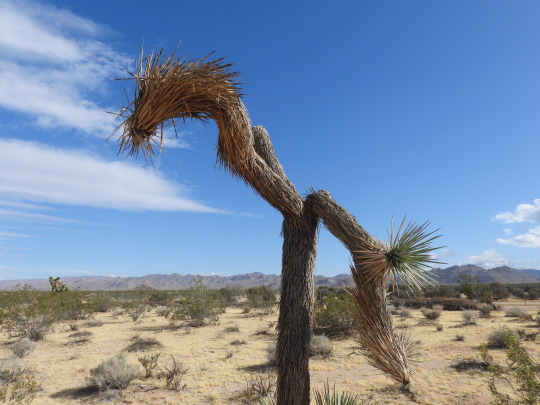

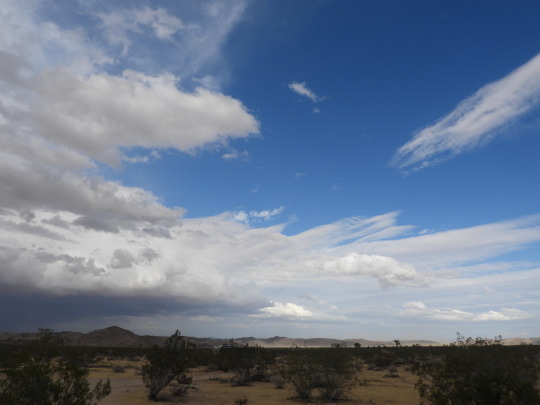
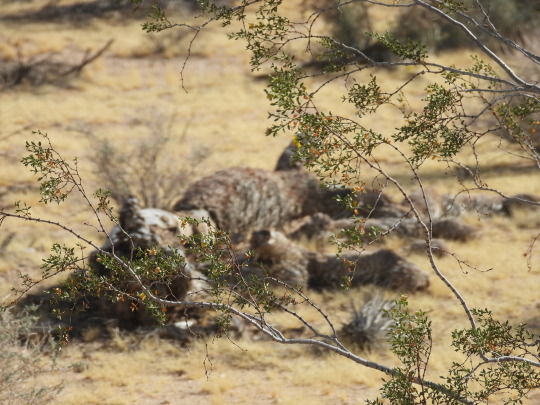

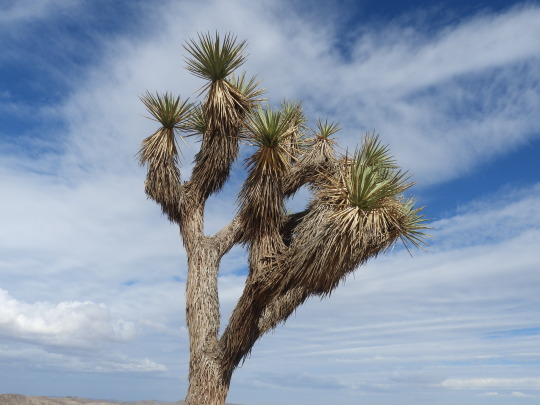
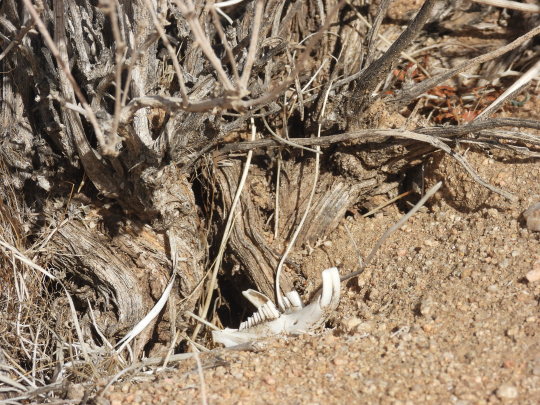


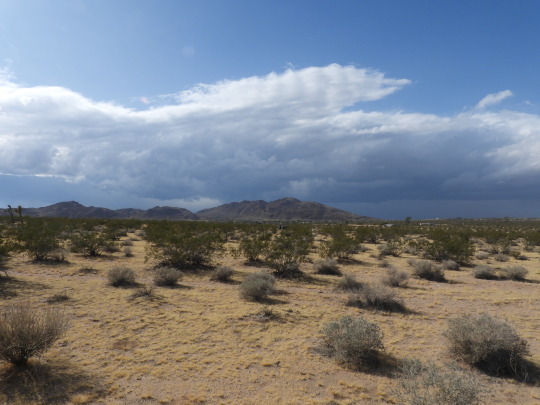

Desert - Near Joshua Tree National Park, 2023
#photography#desert#mojave#mojave desert#joshua tree#california#southwest#waving#bird#human#bones#storm#brewing storm#mountains#nature#ecology#weather#plane#perspective
21 notes
·
View notes
Quote
Unlike the clonal longevity of asexual organisms, sexually reproduced plants and animals usually have briefer, individual life cycles. In short, the enormous diversity afforded by the evolutionary invention of sexual reproduction came with a price—death of the individual.
Richard J. Borden, Ecology and Experience: Reflections from a Human Ecological Perspective
#Richard J. Borden#Ecology and Experience: Reflections from a Human Ecological Perspective#quotelr#quotes#literature#lit#diversity#ecology#individual#life-cycle#sexual-reproduction
6 notes
·
View notes
Text

Weeds, as we call them, are taking on a very different texture for my family this summer. The shop parking lot is overgrown, much to Jacob's frustration. But those plants, those sturdy, sometimes invasive, pioneers of disrupted land, are green and growing now in the heat and drought. The sheep have eaten much of the grass in their paddock, but the gravel lot right next to them is green. Purslane, Korean bush clover, Virginia pepperweed, chicory, crabgrass, pigweed--all of those are food --for us, in some cases, but certainly for the sheep. They watch intently as I fill my arms with fodder, and come within perhaps eight feet in their eagerness to tear into the pile.
Still weeds, yes. But only because they are where they aren't supposed to be. Not because they're worthless.




30 notes
·
View notes
Text
…damn. This episode didn’t pull any punches, did it. And now we gotta wait a week for it to resolve?!
#dungeon meshi#dungeon meshi spoilers#…GOD. I knew it wouldn’t. it’s way too…ecological#but staring at Laios through Falin’s SKULL as he finds it. that perspective#was. BRUTAL.#way worse than Knowing he found the skull and everyone sifting through organs and bones
11 notes
·
View notes
Text
“Countless anthropologists have managed to overlook the ecological dimension of the shaman's craft, while writing at great length of the shaman's rapport with "supernatural" entities. We can attribute much of this oversight to the modern, civilized assumption that the natural world is largely determinate and mechanical, and that that which is regarded as mysterious, powerful, and beyond human ken must therefore be of some other, nonphysical realm above nature, "supernatural."”
—David Abram, The Spell of the Sensuous.
#quote#anthropology#ecology#indigenous#culture#wisdom#civilization#assumption#supernatural#superstition#spirit#nature#mechanistic view#reductionism#science#perspective#perception#mechanical#determinism#dualism
4 notes
·
View notes
Text
Apollo 8’s “Earthrise” photo sparked a modern Copernican revolution of sorts when Anders and his crewmates returned home, splashing down on December 27th. While the Earth may feel vast, expansive, and blessed with what seems like endless resources, to see the world from this epic 200,000 million mile bird’s-eye view is a humbling experience. We could see how wondrous Earth truly is, and perhaps, how vulnerable it is as well.
Anders described the rising Earth as “a Christmas tree ornament, very fragile…[and seemingly of] a physical insignificance and yet it was our home…” The smallness of the Earth in relation to the universe emphasizes the duty we all share in caring for our one and only home in the face of a cold and infinite universe.
The photo was a catalyst for the founding of the modern environmental movement, and just over one year after “Earthrise” the world celebrated its first Earth Day. 20 million inspired Americans, 10% of the country’s population at the time, participated in demonstrations protesting and spreading awareness about environmental degradation. By the end of the year, the United States government created the Environmental Protection Agency and passed trailblazing environmental legislation like the Clean Air Act, Clean Water Act, National Environmental Education Act, and more.
William Anders and his photograph lives on through the environmental movement and the ever-growing participation and importance of Earth Day. When the environmental movement faced the dark and challenging dilemma of a global pandemic just weeks before the 50th Earth Day, Earthrise became a beacon of hope to lead environmentalists through a time where taking action felt harder than ever. Earthrise showed that on this island Earth, the only way forward through global crises is to unite for the common good in support of the one planet we all call home.
William Anders’ legacy serves as an inspiration and a constant reminder of our responsibility to protect this fragile planet we call home. His Earthrise photograph showed that sharing a meaningful image can lead to a profound impact.
3 notes
·
View notes
Text
Yall dont understand how much i missed the forest. And i mean a real forest, not the sterilized, neutered monoculture devoid of life and energy that they call forest in central europe.
Since we as humans are part of a larger community of living beings, we can sense the life around us on an intrinsic level. And we can sense its absence. And if you start to notice the life and energy around you, those sterilized environments feel like sensory deprivation, like wearing figurative earplugs.
It really hit home for me just now, how absolutely destroyed central europe is on an ecological level. Every new day, every new place i get to witness, just refirms this understanding. There is a desperate need for rewilding in this region, to allow natural communities to heal and restore diversity and variance and the chaos that is life on this planet.
But first and foremost there is a need to shift cultural values in the region, before any kind of rewilding can happen. A while back there was this viral post about a french couple demanding the culling of wolves after witnessing a wolf hunting in their backyard. What should be a rare and incredible experience, a privilege and a pleasure to see (and an indicator that the natural communities of the alps have the potential to revive) - to them was a nuciance and a threat to their orderly idyllic cottagecore fsntasy world. It's like their whole culture never moved past the middle ages mentality of achieving safety by "taming" the wild places.
And i've genuinely had (frustrating) conversations with forestry and conservation students from central europe who are literally Afraid of natural forests. Theyre "too wild" and chaotic, lacking the order and control theyre accustomed to in all other parts of their country's society, and require intensive management to bring it to submission and be a "propper" forest. In their eyes, the forest is a resource only growing timber and looking like a city park for them to walk through. Anything that makes obtaining wood more difficult or less profitable is a Problem and needs to be fixed. They dont have any pespective on what an actual natural forest looks and feels like, and look at you like youre an alien if you say what they have arent real forests.
It shows that cultural values in this part of the world stand in direct opposition to the principles of rewilding and re-estsblishing harmony with our place the larger biological community.
So before any large scale restoration can be considered, before actual nature can be brought back to central europe, as desperately as it is needed - not just for its own intrinsic value and right to exist, but also for resillience in the face of the climate crisis - there needs to be a cultural shift that will tolerate coexistence with things that live for their own sake rather than direct human benefit, and which cannot and will not be fundamentally changed to their liking.
And therein lies the crux of this ideology: the rejection of anything that is different from them and will not be subjugated. The need to homogenize everything in their own image. And this mindset is the nucleus at the heart of imperialism. Which is why you cannot separate nature conservation from the ongoing legacy of colonialism, even in the imperial core, and why decolonization needs to be the foundation for any kind of restoration effort.
Tldr: There can be no rewilding of central europe until there is decolonization of european mindsets.
#ecology#rewilding#forest restoration#not to sound too much like a hippy#but even on a purely logical scientific level#you can look at the forest and see the lack of diversity and life. the lack of spatial heterogeny and consequential lack of habitat niches#its structural and visual and audio indicators#on top of the fact that you can indeed feel the difference. if youre used to looking for it#central europe is so fucked#and every passing day cements this realization for me#as an ecologist i approve this post#my own post lol#and down the rabbit hole we go#but its all connected and i hsve no idea how to begin this shift in perspective#when most europeans i meet on the field. even students. refuse to even consider that their worldview isnt inherently superior#that perhaps they are not doing the best at literally everything. including nature management#only time will wear away this european exceptionalism#but europe does not have Time for them to realize this before europe becomes very difficult to sustain livelihoods in
7 notes
·
View notes
Text
Adam Sills’s well-written and beautifully produced Against the Map is in some ways a strange book to review [...] [from the disciplinary perspective of environmental studies]. Sills shows little interest in environmental history or ecocriticism, even in the “ecology without nature” mode [...]. His basic argument is that cartography, because of print capitalism, seeped into all sorts of facets of life on the British Isles during the late seventeenth and eighteenth centuries. It became something that playwrights, novelists, and creative nonfiction types, like Samuel Johnson, developed spaces of resistance to in their publications. Sills highlights the political nature and problematic historical genealogies of maps, an argument that has broader implications for [contemporary] environmental historians who use maps to convey [relatively more “objective” and/or “scientific” information] [...].
Sills begins by accepting the idea, derived from Ben Anderson’s comparative work, that “the history of the map and the history of the modern nation state are inextricably bound up with each other” (p. 1). He then cites two of the key analysts of this in relation to Britain: Richard Helgerson on the literary nationalism of the English Renaissance and John Brewer on the fiscal-military state of the eighteenth century, with its army of surveyors and excise tax collectors. In this historiography, the “surveyor emerges as an authorial figure,” key to the making of the modern state as distinct from traditional dynastic and ecclesiastical authority (p. 3). Combined with cheap printing, the result was what Mary Pedley has called a “democratization of the map” (p. 4). [...]
---
For John Bunyan, the “neighborhood” became a site of resistance (as it is for Denis Wood in his 2010 Everything Sings: Maps for a Narrative Atlas). [...]
For Aphra Behn, [...] the theater and “built environment” of the “fragmented, chameleonlike ... scenic stage” had the ability to challenge coherent representations of the Atlantic empire produced by maps like those of world atlas publisher and road mapper John Ogilby (p. 65).
From Dublin, Jonathan Swift directly satirized the cartographic and statistical impulses of the likes of William Petty, Henry Pratt, and Herman Moll, who all helped visualize London’s colonial relationship with Ireland [...].
From London, Daniel Defoe questioned efforts to define what precisely makes a market or market town through maps and travel itineraries, pointing toward the entropic aspects of the market (“its inherent instabilities and elusive nature”) that challenged and escaped efforts to stabilize such spaces through representations in print (p. 163).
Johnson’s travels to Scotland redefined surveying, resisting the model put forward by the fiscal-military state in the aftermath of the Jacobite Rebellion of 1745.
---
The final chapter and conclusion, “The Neighborhood Revisited,” looks at Jane Austen’s Mansfield Park (1814), a classic novel of the artificial environment of the estate garden. By the early nineteenth century, neighborhoods were more like gated communities and symptomatic of Burkean conservatism and nostalgia. But in Austen’s hands, their structures of affect also suggest the limits of the controversial map- and data-centric literary methodologies [...] and perhaps more broadly the digital humanities. “The principle of spatial difference and differentiation, the heterotopic conceit, always remains a formal possibility, not only at the margins of the empire but at its very center as well,... a possibility that the map cannot acknowledge or register in any fashion” (p. 234). For Sills, this is true of eighteenth-century mapping as well as the fashion for “graphs, maps, and trees” in the early twenty-first century.
---
Sills’s basic argument, that a certain canonical strain of English literature - from Bunyan to Austen - positioned itself “against the map,” seems quite solid. He makes this point most directly by appealing to the work of Mary Poovey on the modern “fact,” with the map as “a rhetorical mode ... that serves to legitimate private and state interests by displacing and, ultimately, effacing the political, religious, and economic impact of those interests” (p. 91).
Nevertheless, returning to a[n] [exclusively] canonical, Bunyan-centered, “small is beautiful” neighborhood approach [potentially ignoring planetary environmental systems, the global context, in cartography] seems limited and problematic from the perspective of Anthropocene [...]. The global maps and mathematics used by the likes of Edmund Halley and Isaac Newton, which were directly satirized by Swift in the Laputa section of Gulliver’s Travels (1726), did something different than Petty’s mapping of Ireland. High-flying as they may have been, such maps and diagrams were key to the development of [...] environmental thinking by Charles Darwin, Charles Lyell, Alexander von Humboldt, and others in the nineteenth century. More recently, global mapping [...], like the internet closely tied initially to the modern American fiscal-military state, have [also later then] been essential to identifying processes of climate change, ocean acidification, deforestation, dead zones, sea level rise, desertification, and a host of other processes that would otherwise be challenging to perceive. This is no mere “Vanity Fair.” Sills’s book would have benefited from engaging with Jason Pearl’s Utopian Geographies and the Early English Novel, published in 2014 [...]. Pearl also does close readings of Behn, Defoe, and Swift, choosing Margaret Cavendish instead of Bunyan and stopping in 1730, just before things became picturesque but just after they were financialized by the South Sea Bubble, Newton’s mint, and Robert Walpole. Pearl reproduces maps by Defoe of Robinson Crusoe’s global travels and of Crusoe’s island, Swift of Houyhnhnmland, Ambrosius Holbein of Thomas More’s Utopia [...].
What if rather than “against the map,” we are seeing struggles between radical and conservative cartography [...] engaged in a fight over the future (utopia)?
What if what [...] [some have] called “capitalist realism” [...], what might in the eighteenth century be called “nationalist realism,” is not the only thing happening with maps and the imagination?
---
Text above by: Robert Batchelor. “Review of Sills, Adam, Against the Map: The Politics of Geography in Eighteenth-Century Britain.” H-Environment, H-Net Reviews. May 2023. Published online at: h-net,org/reviews/showrev,php?id:58887. [Bold emphasis and some paragraph breaks/contractions added by me. In this post, all italicized text within brackets added by me.]
#hmm lot going on here pretty thoughtprovoking for a review#i have lots of thoughts about radical potential of maps for conception of planetary scale and antiimperialism#though simultaneously must remain critical of panopticon aerial perspective of satellite imagery as batchelor says originating with usempire#to acknowledge radical alternatives to imperial mapping in nineteenth century#instead of namedropping humboldt and darwin and chauvinist racist figures i wouldve pointed to#exslaves and abolitionists and their use of global scale conceptions to frame revolutionary atlantic and international solidarity#anyway#abolition#ecology#colonial#imperial cartography#tidalectics#geographic imaginaries#carceral geography#debt and debt colonies#british mapping
19 notes
·
View notes
Text
I always find it interesting that people actively getting degrees in ecology/biology/whatever often have an incredibly negative “it’s unfixable” and “no one really understands how broken it is” viewpoints and can be very outspoken about it. I think part of this is that academia focuses a lot on carbon cycles and the internet in general loves to point fingers are rich people because making broad sweeps is easy.
But unless you’re going into academia or (or like most people with an ecology degree you become a traitor and work on getting housing developments permits build in wetlands), you’re probably going to be working in a community, on small scale actions that often have a clear impact on that community. The “god gave me this land” people are hard to deal with but the citizen “environmentalist” will also be one of the most challenging.
If you’re just going to talk about how the environment is ruined because of big corporations it’s actually a huge insult to the rural, POC, and tribal communities that are taking the brunt of environmental degradation and discriminatory policies. It’s an especially big fuck you to tribes who can be one of the biggest local players in environmental protections/restoration/preservation in an area. Using one example, one homesteader planted knotweed 10 miles up a river in western WA and a tribe now spends almost 100k a year for the past 10 years trying to control it. And that’s one agency of many trying to control it. From the actions of one person.
Rambling post, but sometimes the negativity I see concerns me. If you are choosing a career that will pay you very little, is known to have a high drop out rate, and is usually very emotionally challenging, not tearing down the people working to fix it* is actually an important lesson.
(*fully acknowledging that there do need to be legal and systemic changes here)
#ecology#biology#coming at this from a forestry perspective#actually a tribal forestry perspective#so by individual actions I mean a lot less paper straws and a lot more invasive weeds#ecologist
4 notes
·
View notes
Text
OUGHOGH
Once again please play Monster Hunter the final payoff in Sunbreak is SO GOOD—
#ink thinks#OCEANIZ I OWE YOU MY FUCKING LIFE. THAT WAS SUCH A GOOD EPISODE#crying sobbing over the ending bc it captured my emotions when i finished that fight SO WELL#monster hunter fans PLEASE if you have not. you should definitely watch oceaniz's Forbidden Episodes on monhun ecology#they're told through story perspective and he just posted the one for rise/sunbreak and it SO GOOOOOD AUGH I CRIED
5 notes
·
View notes
Text
im also a mosquito defender just so u know
#buzz buzz#mosquitos are better for the world than vampires tho bc like all non fictional creatures they play an ecological role#i won't go on a rant abt vampires from an ecological perspective i won't go on a rant about v
5 notes
·
View notes
Text
the best part of the Reddit refugee tutorials on how to use tumblr (for me) is that I was never a redditor or on twitter but I did however download tumblr a few months ago, so I get to see all the “tell them about the tumblr holidays” and “this meme is how we transmit important news” memes and sneakily take notes while nodding sagely like I’ve always been here
#the Reddit migration is also just funny#inhabitants of a godless land fled to a land where gods were killed#it’s like watching the collapse of an ecosystem but digitally#my ecology-based idiot brain is loving this from a habitat perspective#acer rambles
3 notes
·
View notes
Text
someday ill write out all my collei thoughts. the college demons are kind of sucking my will to think about anything hard.. break is in 2 weeks..
#ange.txt#oh wait i did have one collei thought about the quest last night :)#sucrose being into biochem modification of nature & collei seeming to be interested in ecology (from her bird talk to eulamber)#that makes me happy :). they should have lots to talk about. i think it would be so fun for them to inform each other from their respective#perspectives on living things!#sucrose's experimentation with living things could also be an interesting thing for collei to engage with. mentally. and seeing it done#kindly rather than how it was done to her.. that might be nice for her to see
4 notes
·
View notes